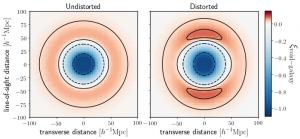Holes in the Universe sharpen cosmic measurements
Regions of the Universe containing very few or no galaxies – known as voids – can help measure cosmic expansion with much greater precision than before, according to new research.

The change in the average shape of voids caused by Doppler distortions and the effects of dark energy and curvature.
The study looked at the shapes of voids found in data from the Sloan Digital Sky Survey (SDSS) collaboration. Voids come in a variety shapes, but because they have no preferred direction of alignment, a large enough sample of them can on average be used as “standard spheres” – objects which should appear perfectly symmetric in the absence of any distortions.
However, the observed shapes of these spheres are distorted by Doppler shifts in the redshifts of nearby galaxies caused by the local velocity field, and by the nature and amounts of dark matter and dark energy that make up 95% of the Universe. This distortion can be theoretically modelled, and the new work shows it can now be precisely measured.
The research was led by the University of Portsmouth, a world leader in cosmology, and is published this week in Physical Review D.
The new measurement of the distortion around voids used the Baryon Oscillation Spectroscopic Survey (BOSS) of galaxies from SDSS, that was designed to measure dark energy and the curvature of space.
For measuring a key aspect of the cosmic expansion, the new method greatly outperforms the standard baryon acoustic oscillation (BAO) technique that BOSS was designed for. The new results agree with the simplest model of a flat Universe with a cosmological constant dark energy, and tighten the constraints on alternative theories.
Lead author, Dr Seshadri Nadathur, research fellow at the University’s Institute of Cosmology and Gravitation (ICG), said: “This measurement tremendously upgrades the previous best results from BOSS – the precision is equivalent to getting data from a hypothetical survey four times as large as BOSS, completely for free. It really helps pin down the properties of dark energy.”
“These results also mean that the expected science results from facilities such as the European Space Agency’s Euclid satellite mission and the Dark Energy Spectroscopic Instrument – in which the astronomy community have invested a lot of resources – can be even better than previously thought.”
Source: U.K. University of Portsmouth
- 236 reads
Human Rights
Ringing FOWPAL’s Peace Bell for the World:Nobel Peace Prize Laureates’ Visions and Actions

Protecting the World’s Cultural Diversity for a Sustainable Future

The Peace Bell Resonates at the 27th Eurasian Economic Summit

Declaration of World Day of the Power of Hope Endorsed by People in 158 Nations

Puppet Show I International Friendship Day 2020

